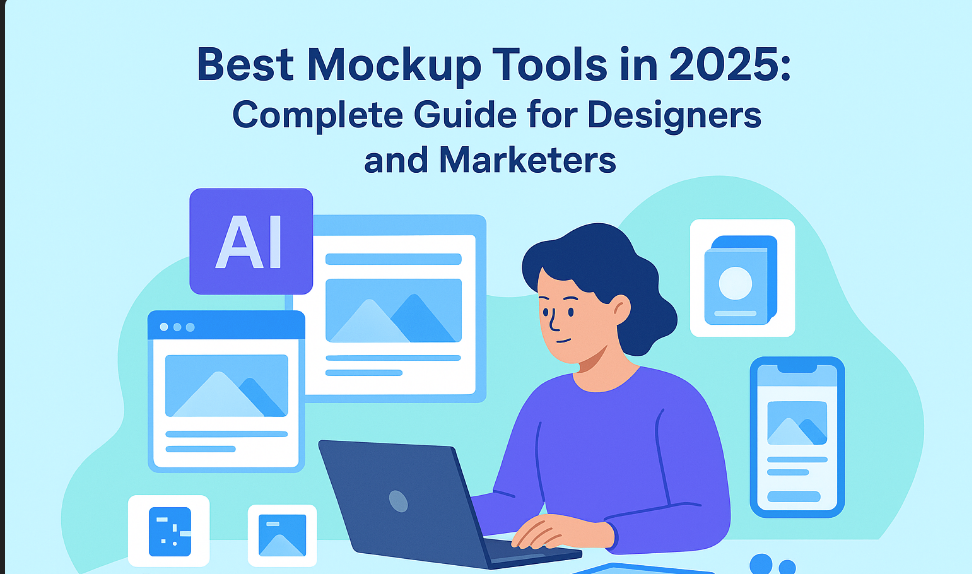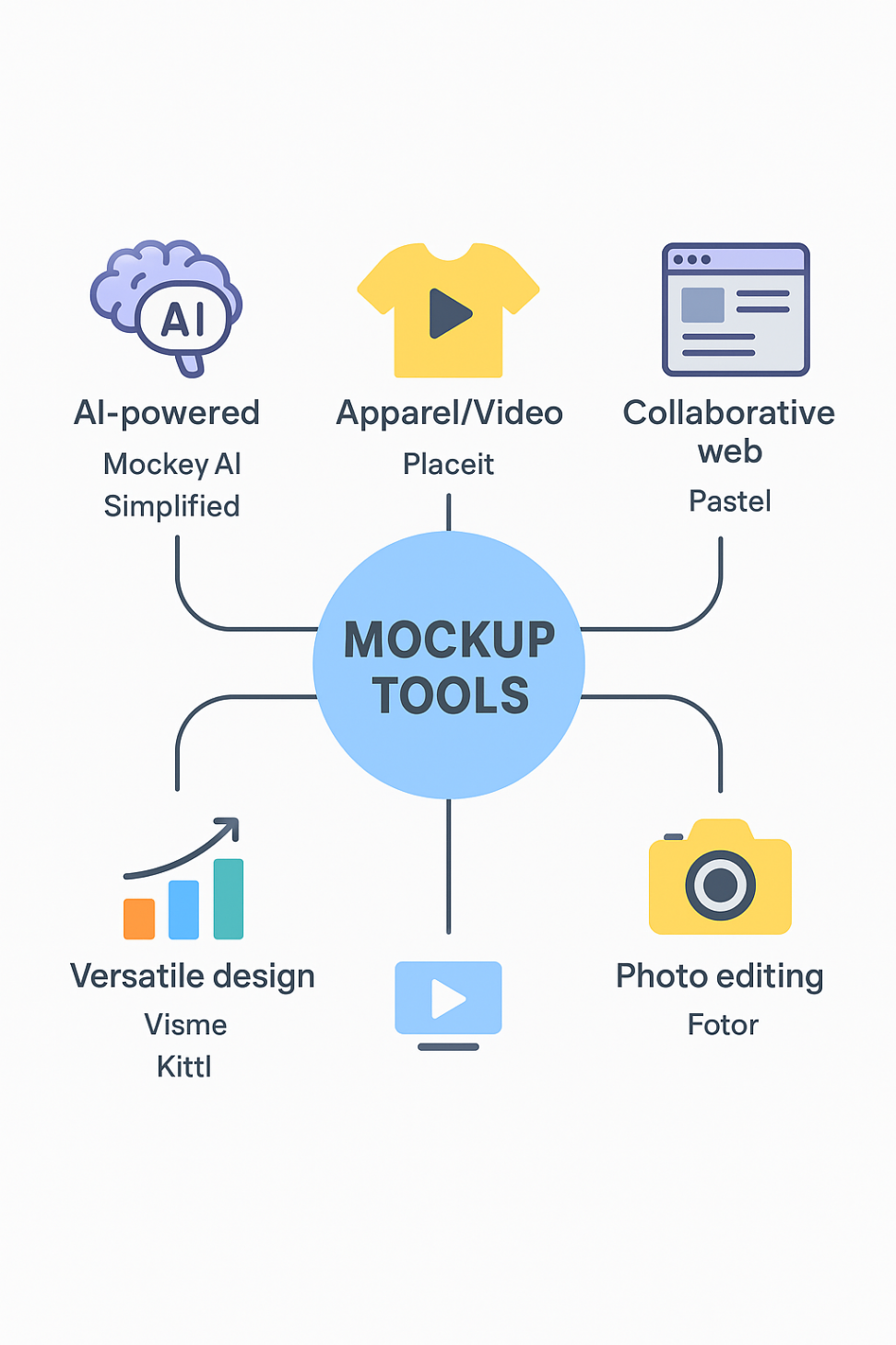We test and review software products using an independent, multipoint methodology. If you purchase something through our links, we may earn a commission. Read about our editorial process.

Making eye-catching content matters now more than ever. It is something every brand, marketer, and designer needs. Mockup tools help you see your ideas in real-world setups, including physical products. You get to test website design and show quick interactive prototypes. This lets you show the most important design elements and user interface to clients in different formats before anything gets made. In 2025, mockup tools do more than just build simple pictures. The new mockup software uses AI, comes with a wide range of features, and lets people work together in real-time. There is also more automation, so your work is faster and matches your brand. If you make marketing materials, build websites, or design product mockups, using good software saves you time. It also makes the content you share better for all of us.
Visme has become known as a tool that works well for both beginners and people who have experience in design. The drag-and-drop editor, with its simple interface, lets you make mockups for many things. You can use it for social media graphics, business cards, or even big marketing materials. Many people like that Visme has a wide range of templates. This means that even if you do not have much practice with design, you can still make great visuals.
Visme also lets you work on things other than mockups. You can create infographics, charts, and even interactive content. It is a good pick for marketers who want to keep the same style for their brand on all their channels. Some advanced features are only open if you pay, but the free version is still useful. You can get a feel for the tool and finish a single project while enjoying a free trial with the free version.
Mockey AI is one of the new mockup tools that uses AI to help you make mockups faster. You get thousands of templates for shirts, hats, and tech gear. The AI in Mockey AI changes each part so it fits right and looks real. This means you do not have to spend a lot of time fixing things by hand. Marketers and designers who need to work fast will find Mockey AI very useful. You can make mockups that look good, and even free users do not get watermarks. That really helps if you are new to digital marketing or starting a campaign. Mockey AI cares about making your work quick and easy. It gives you quality mockup tools that are great for e-commerce sites and product launches, where you need good-looking images and have no time to waste.
Placeit is a top pick for many people needing mockup images for clothes, brands, or videos. The site has a big library with lots of templates. These templates cover clothing, tech, and lifestyle items. You get scenes that are ready to use and look real and neat. A great thing about Placeit is that anyone can quickly make their own mockup. This makes the tool good for marketing teams who want to make a lot of pictures fast. You need the annual subscription to get everything. But with so many choices and how simple Placeit is, it works well for designers and marketers who do branded content and ads.
Simplified is made for teams and people who want to make design work easier. You can use it for more than just mockup designs. It has smart tools with AI that help with things like resizing content for you, applying your brand look, and giving you ideas for templates. This is great for anyone who manages social media, works in marketing, or runs a small business. If you need marketing materials for more than one platform, you can use easy sharing. The tool automates jobs that you do over and over. It also gives you ideas for edits as you work. Simplified can save you time on design, help your work look more alike and feel more together, and make sure your marketing materials on social media always feel professional and match your brand.
For teams that work on web design, Pastel gives a different way to share ideas. Much more than tools that are only for showing what a product will look like, Pastel lets people leave their comments right on the web pages in real time. You can use this with designers and others in the team so feedback is quick and talking to each other is easy. This is very helpful for agencies or teams in different places who need fast answers and want everyone to stay on the same page. Pastel may not be the best for making pictures of products you can hold, but its real time collaboration features are a must-have for web design. With Pastel, you can change layouts, test new ideas for looks, and be sure your work is what your clients want.
Kittl is a design tool that helps you make product mockups and pictures with many details using various UI components. The tool uses an intuitive drag-and-drop interface so you can change things fast and see updates in real time. This lets you see how your ideas look right away, and make sure all parts match your plan. It is the perfect fit for projects when you want to get everything just right.
People like to use Kittl for work that needs careful attention, like adding sound effects, making packaging design, building presentation graphics, and creating sharp marketing visuals. If you are brand new to these types of tools, it may take a little time to learn how Kittl works. But its strong features make many professionals pick it when they want clean, high-quality results.
Fotor is well-known as a photo editing website, but now it also lets you make mockups using new AI tools. The site helps you take out backgrounds, make your photos look better right away, and use easy templates. You can quickly make marketing images with just a few clicks. The AI features in Fotor are very helpful for small teams and people working alone, because you don’t need to be a designer to get good results. The easy-to-use design and how simple the website is make it a good choice for marketing workers who want to make great images fast. You still get a clean, professional look in the end.

Choosing a mockup tool for a mobile app comes down to what you need for mobile devices and other devices. If you want speed and help with automation, the AI-powered tools like Mockey AI and Simplified can help you save time, facilitating a more efficient design process. They still keep product design looking good and fresh. If team collaboration and getting feedback on the web matter most, Pastel offers strong support for team workflows and helps you work well with others.
Designers who need to work on branding or marketing materials may want to use Visme or Placeit. These have ready-to-use templates and look professional, making them a good choice. Money also comes into play; some of these tools are free for basic use, but to get premium features, you need to pay a subscription. Make sure you check what fits your budget.
Think about how easy the tool is to use. A smooth learning curve is important, especially if several team members will be working with the software. Choose one that speeds up the job for people, on a mobile app or other devices, and brings good value to your product design and team collaboration.
To get the most from mockup tools, make sure to plan how to add them to your daily work. Think about the initial learning curve and how you can get used to it. Use the AI features to try out lots of design ideas quickly. Keep your brand the same in all the pictures you make. Export in high-resolution formats. You can also use export options, which help when you show your work to clients or want to use it in marketing. Save your mockup files and share them easily by linking your mockup tools to Google Drive.
Try several templates and work with different design ideas to see which ones your audience likes most when you test design ideas, including how they perform across various web browsers. You can add analytics tools to check how people interact with your visuals. This lets you improve what you do next time. After a while, you will get better at the workflow, get your designs looking good, and make sure your mockup work matches your goals for marketing.
The best mockup tool for you will depend on the project you have, how you work, and what you want to get done with the design. Visme and Simplified work well if you need to make different kinds of mockups and want a tool that can be used in many ways, especially for a single page. Mockey AI is fast and uses AI to make mockups quickly. Placeit is the top choice when you are making mockups for clothes or video content. Kittl and Fotor help you get good and clear results. Pastel is good if people need to work together and give feedback on web projects.
Adobe XD and Adobe Photoshop, along with Adobe Suite and Mockuuups Studio, are great for both new and advanced designers who want to make previews for all sorts of apps. If you look at what you need and use the best parts of these tools, you can make your design flow better, get professional looking visuals fast, and create marketing materials that stand out from the others.
Mockups add color and style to wireframes by showing what the design will look like with different ui elements. They give a clear idea of the layout. Prototypes help people try out real user experiences and make it clear what happens when you click or tap on things. This is done by using rules for each action. A wireframe is the starting point of the design process. It focuses on the structure and where things go, but does not add style or color yet.
Yes, there are some good free choices for beginners. Tools like UXPin and Fluid UI are great for this. They offer you mockup templates and lots of UI components to use. These can help you learn the basics of design. You can start as a beginner and make something that looks good quickly. This is a good way to practice and get better at using ui components and mockup templates. Fluid UI is easy to use, so it will help you feel more sure while you learn.
Yes, that's right. Mockup tools are here to help you with web design projects. You can use them for work with mobile devices and on the web. These platforms let you get different formats and mockups, including UI designs for apps. They also make layouts for websites, so these look good on various devices.
Use built-in collaboration features like real-time updates, easy sharing, and tools for commenting. Marvel is a tool that helps with team collaboration and keeping everyone in the loop about design ideas. This makes it easy for the team to stay connected. Everyone will know what is going on. Stakeholders can give feedback right in the tool. This way, no notes or ideas get lost.